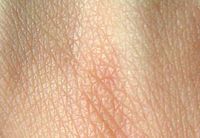
Photo from wikipedia
The measurement of Trans-Epidermal Water Loss (TEWL) allows to evaluate the integrity of Stratum Corneum Epidermis (SCE) barrier after topical application of colloidal nanocarriers by using a non-invasive method. The… Click to show full abstract
The measurement of Trans-Epidermal Water Loss (TEWL) allows to evaluate the integrity of Stratum Corneum Epidermis (SCE) barrier after topical application of colloidal nanocarriers by using a non-invasive method. The temporarily modifications of SCE lipids are important for the passage of colloidal nanocarriers across the skin; this passage causes a modification of TEWL values. Niosomes, ethosomes®, and transfersomes® are used as topical drug delivery systems due to their biopharmaceutical properties, and capability to permeate intact through the SCE. In vitro and in vivo evaluation of TEWL values was studied for niosomes, ethosomes® and transfersomes® in occlusive and non-occlusive conditions. TEWL values in vivo, using healthy human volunteers, are ∼12 g/m2∙× h for all nanoformulations after 72 h, due to the rearrangement of lipids forming the SCE membranes. Conversely, TEWL values of healthy human volunteers, that are topically treated with niosomes, ethosomes® and transfersomes®, in non-occlusive conditions, are ∼20 g/m2∙× h. This data was lower than those obtained in occlusive conditions (∼35 g/m2∙× h). In vitro studies agreed results which are obtained in occlusive conditions using healthy human volunteers. SCE lipids of the skin restore their native structure after 72 h of nanocarrier application. In vitro and in vivo results showed that niosomes, ethosomes®, and transfersomes® interact with the skin in a temporary and reversible mode, and they can be used as suitable colloidal nanocarriers to increase the percutaneous permeation of drugs after topical application without damaging the native structure of the skin.
Journal Title: Journal of pharmaceutical and biomedical analysis
Year Published: 2020
Link to full text (if available)
Share on Social Media: Sign Up to like & get
recommendations!